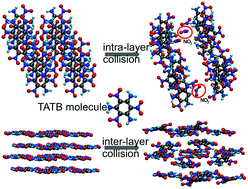Anisotropic mechanoresponse of energetic crystallites: a quantum molecular dynamics study of nano-collision†
Abstract
At the nanoscale, chemistry can happen quite differently due to mechanical forces selectively breaking the chemical bonds of materials. The interaction between chemistry and mechanical forces can be classified as mechanochemistry. An example of archetypal mechanochemistry occurs at the nanoscale in anisotropic detonating of a broad class of layered energetic molecular crystals bonded by inter-layer van der Waals (vdW) interactions. Here, we introduce an ab initio study of the collision, in which quantum molecular dynamic simulations of binary collisions between energetic vdW crystallites, TATB molecules, reveal atomistic mechanisms of anisotropic shock sensitivity. The highly sensitive lateral collision was found to originate from the twisting and bending to breaking of nitro-groups mediated by strong intra-layer hydrogen bonds. This causes the closing of the electronic energy gap due to an inverse Jahn–Teller effect. On the other hand, the insensitive collisions normal to multilayers are accomplished by more delocalized molecular deformations mediated by inter-layer interactions. Our nano-collision studies provide a much needed atomistic understanding for the rational design of insensitive energetic nanomaterials and the detonation synthesis of novel nanomaterials.


 Please wait while we load your content...
Please wait while we load your content...